11.1: Gender and Biology
11.1.1: The Role of Biology
Biology determines sex, while social norms determine gender.
Learning Objective
Define and differentiate between sex and gender
Key Points
- Though males and females have biological differences, they are more similar than is usually expected. Difference arises from cultural expectations.
- Gender takes many forms and is shaped by religious, political, legal, philosophical, linguistic, and other traditions.
- Social constructs around gender often have a biological component. For example, historically in many cultures women are seen as the weaker sex, both because they have been relegated to less powerful social roles and because biologically, women tend to have less muscle mass.
Key Terms
- gender
-
The socio-cultural phenomenon of the division of people into various categories such as male and female, with each having associated roles, expectations, stereotypes, etc.
- sex
-
Either of two main divisions (female or male) into which many organisms can be placed, according to reproductive function or organs.
Example
- The hijras of the Indian subcontinent are traditionally either eunuchs (castrated biological males) or born with ambiguous genitalia. Although hijras dress as women and exhibit what is normally considered as “feminine” behavior, they believe themselves to belong to a “third gender,” identifying neither as male nor female.
It is important to distinguish between sex and gender. Sex refers to a person’s biological make-up as male or female. Typically, a person’s genotype (genetic makeup) and phenotype (observable traits) are used to determine a person’s sex. Males are defined as having an XY 23rd chromosome, while females are defined as having an XX 23rd chromosome (though tests have revealed variations in chromosomes, including XXY, XYY, and XXX). Scientists have linked a person’s 23rd chromosome to the development of a sexed phenotype. Anatomically, males and females have different reproductive organs: a penis, testicles, and scrotum for males, and a vagina, uterus, and ovaries for females. Other anatomical differences include the development of breasts among females, and the presence of a menstrual cycle.
Male and female are generally understood as discrete categories, often referred to as “opposite” sexes. In fact, the majority of male and female biology is identical. Male and female reproductive systems are distinct, but otherwise most bodily systems function the same way. With regards to digestive, respiratory, circulatory, lymphatic, musculoskeletal, nervous, immune, sensory, endocrine, and integumentary systems, males and females have many more similarities than differences. Likewise, males and females have nearly all the same hormones present in their bodies, though the amount of certain hormones (such as estrogen and testosterone) varies.
While sex is the determination of whether a person is biologically male or female, gender is the sociocultural determination of
understanding of what it means to be a man or a woman. Sex is largely constant across different cultures; in virtually any country, a person with XY chromosomes and male reproductive organs is considered male. Gender, however, takes many forms and is shaped by religious, political, legal, philosophical, linguistic, and other traditions. For example, in some countries, wearing make-up is associated with women and is seen as feminine. Elsewhere, men routinely wear make-up and it is seen as masculine. Across history in most parts of the world, women have been denied access to economic independence and legal and political rights more often than men have. This oppression is based on cultural understandings of women as the weaker sex, but is often linked to females’ biological capacity for bearing and nursing children.
Some physical differences between the male and female sexes are thought to occur as a result of both biological and cultural processes. For example, on average, males have more upper body strength than females. This difference is partially the result of differences in the biological development of the musculoskeletal system, but is exacerbated by the cultural tendency for men to use their upper body muscles more than women through physical labor and athletics . Similarly, males have a shorter life expectancy than females do, on average. Again, this may partially result from different biological make-ups, but decreased life-expectancy gaps in developed countries proves that cultural institutions contribute to the gap. When men and women have similar careers and lifestyles, the life-expectancy gap decreases.

The Male Anatomy
The male reproductive system is clearly distinct from that of the female.
11.2: Gender and Socialization
11.2.1: Gender Socialization
Gender socialization is the process by which males and females are informed about the norms and behaviors associated with their sex.
Learning Objective
Explain the influence of socialization on gender roles and their impact
Key Points
- Gender socialization is the process by which individuals are taught how to socially behave in accordance with their assigned gender, which is assigned at birth based on their biological sex.
- Today it is largely believed that most gender differences are attributed to differences in socialization, rather than genetic and biological factors.
- Gender stereotypes can be a result of gender socialization: girls and boys are expected to act in certain ways that are socialized from birth. Children and adults who do not conform to gender stereotypes are often ostracized by peers for being different.
- While individuals are typically socialized into viewing gender as a masculine-feminine binary, there are individuals who challenge and complicate this notion. These individuals believe that gender is fluid and not a rigid binary.
Key Terms
- gender
-
The socio-cultural phenomenon of the division of people into various categories such as male and female, with each having associated roles, expectations, stereotypes, etc.
- Gender socialization
-
The process of educating and instructing males and females as to the norms, behaviors, values, and beliefs of group membership as men or women.
- sex
-
Either of two main divisions (female or male) into which many organisms can be placed, according to reproductive function or organs.
Sociologists and other social scientists generally attribute many of the behavioral differences between genders to socialization. Socialization is the process of transferring norms, values, beliefs, and behaviors to group members. The most intense period of socialization is during childhood, when adults who are members of a particular cultural group instruct young children on how to behave in order to comply with social norms. Gender is included in this process; individuals are taught how to socially behave in accordance with their assigned gender, which is assigned at birth based on their biological sex (for instance, male babies are given the gender of “boy”, while female babies are given the gender of “girl”). Gender socialization is thus the process of educating and instructing males and females as to the norms, behaviors, values, and beliefs of group membership .

Rosie the Riveter
“Rosie the Riveter” was an iconic symbol of the American homefront in WWII. The entrance of women into the workforce (and into traditionally male roles) marked a departure from gender roles due to wartime necessity.
Preparations for gender socialization begin even before the birth of the child. One of the first questions people ask of expectant parents is the sex of the child. This is the beginning of a social categorization process that continues throughout life. Preparations for the birth often take the infant’s sex into consideration (e.g., painting the room blue if the child is a boy, pink for a girl). Today it is largely believed that most gender differences are attributed to differences in socialization, rather than genetic and biological factors.
Gender stereotypes can be a result of gender socialization. Girls and boys are expected to act in certain ways, and these ways are socialized from birth by many parents (and society). For example, girls are expected to be clean and quiet, while boys are messy and loud. As children get older, gender stereotypes become more apparent in styles of dress and choice of leisure activities. Boys and girls who do not conform to gender stereotypes are usually ostracized by same-age peers for being different. This can lead to negative effects, such as lower self-esteem.
In Western contexts, gender socialization operates as a binary, or a concept that is exclusively comprised of two parts. In other words, individuals are socialized into conceiving of their gender as either masculine (male) or feminine (female). Identities are therefore normatively constructed along this single parameter. However, some individuals do not feel that they fall into the gender binary and they choose to question or challenge the male-masculine / female-feminine binary. For example, individuals that identify as transgender feel that their gender identity does not match their biological sex. Individuals that identify as genderqueer challenge classifications of masculine and feminine, and may identify as somewhere other than male and female, in between male and female, a combination of male and female, or a third (or forth, or fifth, etc.) gender altogether. These identities demonstrate the fluidity of gender, which is so frequently thought to be biological and immutable. Gender fluidity also shows how gender norms are learned and either accepted or rejected by the socialized individual.
11.2.2: The Social Construction of Gender
Social constructivists propose that there is no inherent truth to gender; it is constructed by social expectations and gender performance.
Learning Objective
Explain Judith Butler’s concept of gender performativity
Key Points
- Social constructionism is the notion that people’s understanding of reality is partially, if not entirely, socially situated.
- Gender is a social identity that needs to be contextualized.
- Individuals internalize social expectations for gender norms and behave accordingly.
Key Terms
- social constructionism
-
The idea that social institutions and knowledge are created by actors within the system, rather than having any inherent truth on their own.
- Gender performativity
-
Gender Performativity is a term created by post-structuralist feminist philosopher Judith Butler in her 1990 book Gender Trouble, which has subsequently been used in a variety of academic fields that describes how individuals participate in social constructions of gender.
- essentialism
-
The view that objects have properties that are essential to them.
Social Constructionism
The social construction of gender comes out of the general school of thought entitled social constructionism. Social constructionism proposes that everything people “know” or see as “reality” is partially, if not entirely, socially situated. To say that something is socially constructed does not mitigate the power of the concept. Take, for example, money. Money is a socially constructed reality. Paper bills are worth nothing independent of the value individuals ascribe to them. The dollar is only worth as much as value as Americans are willing to ascribe to it. Note that the dollar only works in its own currency market; it holds no value in areas that don’t use the dollar. Nevertheless, the dollar is extremely powerful within its own domain.
These basic theories of social constructionism can be applied to any issue of study pertaining to human life, including gender. Is gender an essential category or a social construct? If it is a social construct, how does it function? Who benefits from the way that gender is constructed? A social constructionist view of gender looks beyond categories and examines the intersections of multiple identities and the blurring of the boundaries between essentialist categories. This is especially true with regards to categories of male and female, which are viewed typically as binary and opposite. Social constructionism seeks to blur the binary and muddle these two categories, which are so frequently presumed to be essential.
Judith Butler and Gender Performativity
Judith Butler is one of the most prominent social theorists currently working on issues pertaining to the social construction of gender. Butler is a trained philosopher and has oriented her work towards feminism and queer theory. Butler’s most known work is Gender Trouble: Feminism and the Subversion of Identity, published in 1991, which argues for gender performativity. This means that gender is not an essential category. The repetitious performances of “male” and “female” in accordance with social norms reifies the categories, creating the appearance of a naturalized and essential binary. Gender is never a stable descriptor of an individual, but an individual is always “doing” gender, performing or deviating from the socially accepted performance of gender stereotypes. Doing gender is not just about acting in a particular way. It is about embodying and believing certain gender norms and engaging in practices that map on to those norms. These performances normalize the essentialism of gender categories. In other words, by doing gender, we reinforce the notion that there are only two mutually exclusive categories of gender. The internalized belief that men and women are essentially different is what makes men and women behave in ways that appear essentially different. Gender is maintained as a category through socially constructed displays of gender.
Doing gender is fundamentally a social relationship. One does gender in order to be perceived by others in a particular way, either as male, female, or as troubling those categories. Certainly, gender is internalized and acquires significance for the individual; some individuals want to feel feminine or masculine. Social constructionists might argue that because categories are only formed within a social context, even the affect of gender is in some ways a social relation. Moreover, we hold ourselves and each other for our presentation of gender, or how we “measure up.” We are aware that others evaluate and characterize our behavior on the parameter of gender. Social constructionists would say that gender is interactional rather than individual—it is developed through social interactions. Gender is also said to be omnirelevant, meaning that people are always judging our behavior to be either male or female.

Judith Butler
Author of Gender Trouble: Feminism and the Subversion of Identity.
11.2.3: Gender Identity in Everyday Life
Gender identity is one’s sense of one’s own gender. It is the result of socialization, but it also has a biological basis.
Learning Objective
Discuss the difference between biological and social construction of gender identity
Key Points
- Gender identity typically falls on a gender binary—individuals are expected to exclusively identify either as male or female. However, some individuals believe that this binary model is illegitimate and identify as a third, or mixed, gender.
- Individuals whose gender identity aligns with their sex organs are said to be cisgender. Transgender individuals are those whose gender identity does not align with their sex organs.
- Gender identity discourse derives from medical and psychological conceptions of gender. There is vigorous debate over biological versus environmental causes of the development of one’s gender identity.
- As gender identities come to be more disputed, new legal frontiers are opening on the basis that a male/female gender binary, as written into the law, discriminates against individuals who either identify as the opposite of their biological sex or who do not identify as either male or female.
- The extreme cultural variation in notions of gender indicate the socially constructed nature of gender identity.
Key Terms
- gender binary
-
A view of gender whereby people are categorized exclusively as either male or female, often basing gender on biological sex.
- transgender
-
Not identifying with culturally conventional gender roles and categories of male or female; having changed gender identity from male to female or female to male, or identifying with elements of both, or having some other gender identity.
- cisgender
-
Identifying with or experiencing a gender the same as one’s biological sex or that is affirmed by society, e.g. being both male-gendered & male-sexed.
Example
- The berdaches, or the Two-Spirit People, are indigenous North Americans who, although biologically male, assume one of many mixed gender roles. These “third” gender roles involve engaging in work and wearing clothing associated with both men and women. This could include medicine, fortune-telling, conveying oral traditions and songs, and match-making.
Gender identity is one’s sense of being male, female, or a third gender. Gender identity typically falls on a gender binary—individuals are expected to exclusively identify either as male or female. However, some individuals believe that this binary model is illegitimate and identify as a third, or mixed, gender. Gender identity is socially constructed, yet it still pertains to one’s sense of self. Gender identity is not only about how one perceives one’s own gender, but also about how one presents one’s gender to the public.
Cisgender and Transgender
Individuals whose gender identity aligns with their sex organs are said to be cisgender. Transgender individuals are those whose gender identity does not align with their sex organs. These people generally dress according to how they feel but do not make an drastic change within their sexual organs. Transsexuals, however, take drastic measures to assume their believed identity. This includes hormone therapy and sexual reassignment operations. Recently, there has been a growing gender/queer movement consisting of individuals who do not feel that their sex organs are mismatched to their gender identity, but who still wish to trouble the notion of a gender binary, considering it overly simplistic and misrepresentative.
Causes of Confusion in Gender Identity
What causes individuals to sense a sort of confusion between their biological gender and their gender identity? This question is hotly contested, with no clear answer. Some scientists argue that the sense of confusion is a biological result of the pre- and post-natal swinging of hormone levels and genetic regulation. Sociologists tend to emphasize the environmental impetuses for gender identity. Certainly, socialization, or the process of transferring norms, values, beliefs, and behaviors to group members, plays a significant part in how individuals learn and internalize gender roles and subsequently impact their gender identity.
Though the medical emphasis in some conversations about gender identity is frequently scrutinized by sociologists, there is clearly some biological basis to gender, even if it has more to do with appearances and social presentation than identity formation. Women have two X chromosomes, where men have one X and one Y chromosome. However, despite the deep relationship to biology, gender identity cannot only be biologically determined. However, gender identity has a larger social component that needs to be considered. For example, although a person may be biologically male, “he” may feel more comfortable with a female identity, which is a social construction based on how he feels, not his physical makeup.
Gender Identities and Law
As gender identities come to be more disputed, new legal frontiers are opening on the basis that a male/female gender binary, as written into the law, discriminates against individuals who either identify as the opposite of their biological sex or who identify as neither male nor female. On college campuses, gender-restrictive dorm housing is facing opposition by individuals who identify as neither a man nor a woman. Many public spaces and workplaces are instituting gender-neutral bathroom facilities. Gender identity has become a piece of international law as a branch of human rights doctrines. The Yogyakarta Principles, drafted by international legal scholars in 2006, provide a definition of gender identity in its preamble. In the Principles “gender identity” refers to each person’s deeply felt internal and individual experience of gender, which may or may not correspond with the biological sex assigned at birth, including the person’s sense of the body and other expressions of gender.
Gender Identities across Cultures
Gender identities, and the malleability of the gender binary, vary across cultures. In some Polynesian societies, fa’afafine are considered to be a third gender alongside male and female. Fa’afafine are accepted as a natural gender and are neither looked down upon nor discriminated against. They are biologically male, but dress and behave in a manner that Polynesians typically consider female. Fa’afafine are often physiologically unable to reproduce. Fa’afafine also reinforce their femininity by claiming to be only attracted to and receiving sexual attention from heterosexual men.
In the Indian subcontinent, a hijra is usually considered to be neither male nor female. The hijra form a third gender, although they do not enjoy the same acceptance and respect as individuals who identify along the gender binary.
The xanith form an accepted third gender in Oman, a society that also holds a gender binary as a social norm. The xanith are male, homosexual prostitutes whose dressing is male, featuring pastel colors rather than the white clothes traditionally worn by men, but their mannerisms are coded as female. Xanith can mingle with women where men cannot. However, similar to other men in Oman, xanith can marry women and prove their masculinity by consummating the marriage. This extreme cultural variation in notions of gender indicate the socially constructed nature of gender identity.

Men in Montreal Dressed in Drag
The image above exemplifies the subjective and personal understanding people have of their own gender identities.
11.2.4: Gender Roles in the U.S.
Gender roles refer to the set of social and behavioral norms that are considered to be appropriate for people of a specific sex.
Learning Objective
Describe how gender roles in the U.S. have changed since the 1950’s
Key Points
- Gender roles are never universal, even within a single country, and they are always historically and culturally contingent.
- Gender role theory emphasizes environmental conditions and the influence of socialization, or the process of transferring norms, values, beliefs, and behaviors to group members, in learning how to behave as a male or female.
- Current trends toward a total integration model of gender roles is reflected in women’s education, professional achievement, and family income contributions.
Key Terms
- Division of labor
-
A division of labour is the dividing and specializing of cooperative labour into specifically circumscribed tasks and roles.
- socialization
-
The process of learning one’s culture and how to live within it.
- nuclear family
-
a family unit consisting of at most a father, mother and dependent children.
Gender roles refer to the set of social and behavioral norms that are considered to be socially appropriate for individuals of a specific sex. There has been significant variation in gender roles over cultural and historical spans, and all gender roles are culturally and historically contingent. Much scholarly work on gender roles addresses the debate over the environmental or biological causes for the development of gender roles. The following section seeks to orient the reader to the sociological theorization of the gender role and discuss its application in an American context.
Gender and Social Role Theory
Gender role theory posits that boys and girls learn to perform one’s biologically assigned gender through particular behaviors and attitudes. Gender role theory emphasizes the environmental causes of gender roles and the impact of socialization, or the process of transferring norms, values, beliefs, and behaviors to group members, in learning how to behave as a male or a female. Social role theory proposes that the social structure is the underlying force in distinguishing genders and that sex-differentiated behavior is driven by the division of labor between two sexes within a society. The division of labor creates gender roles, which in turn, lead to gendered social behavior.
Gender Roles in the United States
With the popularization of social constructionist theories of gender roles, it is paramount that one recognize that all assertions about gender roles are culturally and historically contingent. This means that what might be true of gender roles in the United States for one cultural group likely is not true for another cultural group. Similarly, gender roles in the United States have changed drastically over time. There is no such thing as a universal, generalizable statement about gender roles.
One main thread in discussions about gender roles in the United States has been the historical evolution from a single-income family, or a family unit in which one spouse (typically the father) is responsible for the family income, to a dual-income family, or a family unit in which both spouses generate income. Before the rise of feminism in the 1960s and 1970s and the influx of women into the workforce in the 1980s, women were largely responsible for dealing with home matters, while men worked and earned income outside the home. While some claim that this was a sexist structure, others maintain that the structure simply represented a division of labor, or a social system in which a particular segment of the population performs one type of labor and another segment performs another type.
Nuclear Family Models
In 1955, sociologist Talcott Parsons developed a model of nuclear families in the United States that addressed gender roles. Family structures vary across cultures and history, and the term nuclear family refers to a family unit of two parents and their children. Parsons developed two models of gender roles within the nuclear family. His first model involved total role segregation; men and women would be trained and educated in gender-specific institutions, and high professional qualifications and the workplace would be intended for men. Women would be primarily focused on housekeeping, childcare, and children’s education. Male participation in domestic activity would be only partially desired and socially acceptable. Further, in the case of conflict, the man would have the final say. Parsons contrasted this first model with a second that involved the total integration of roles. In the second model, men and women would be educated in the same institutions and study the same content in classes. Outside the educational milieu, women and men would both perceive career to be important, and equal professional opportunities for men and women would be considered socially necessary. Both parties in a marriage would bear responsibility for housework and child rearing. Finally, neither gender would systematically dominate decision making.
Current Trends
Of course, neither of Parsons’s models accurately described the United States in the 1950s, and neither model accurately describes the United States in the present day. However, total role segregation was closer to the reality of the United States in the 1950s, whereas a total integration of roles is increasingly common in the United States today.
The national trend toward a total integration of gender roles is reflected in women’s education, professional achievement, and family income contributions. Currently, more women than men are enrolled in college, and women are expected to earn more graduate degrees than men over the next several years. In 2005, 22% of American households had two income earners, which suggests the presence of women in the workforce. However, in most contexts, women are still expected to be the primary homemakers, even if they are contributing to household income by working outside the home.

Women Behind the Wheel, 1952
This image, from the magazine Beauty Parade, offers a stereotyped view of female drivers.
11.2.5: The Cross-Cultural Perspective
Gender roles vary widely across different cultural contexts.
Learning Objective
Compare and contrast gender roles in different cultures
Key Points
- It is impossible to generalize what life is like for one woman from assumptions about gender roles in different countries.
- To assess what daily life is like for women, one must learn the particulars about the cultural and historical moment she occupies.
- In Sweden, all working parents are entitled to sixteen months paid leave per child. To encourage greater paternal involvement in childrearing, a minimum of two months out of the sixteen is required to be used by the “minority” parent, usually the father.
- 62% of Chileans are opposed to full gender equality and believe that women should limit themselves to the roles of mother and wife. Until recently, women lost their right to administer their own assets once they were married, and were required by law to obey their husbands.
- Women in Japan are usually well-educated and employed, though gender dynamics emerge in regards to social pressure to find a husband. Historically, gender has been an important principle of Japanese social stratification, but gender differences have varied over time and within social class.
Key Terms
- Michelle Bachelet
-
Chile’s first female president (2006-2010).
- parental leave
-
A leave of absence from a job for a parent to take care of a baby.
Gender roles vary significantly across cultures. Indeed, all gender roles are culturally and historically contingent, meaning that they cannot be analyzed outside of their cultural and historical contexts. This section attempts to provide a few examples of variation in gender roles and the lives of women in various places around the world. These small glimpses are not universal by any means, but this overview should provide a brief summary of just how much women’s lives vary and how much women’s lives seem similar across national boundaries.
Gender Roles in Sweden
Governments in Europe are typically more active in governing the lives of their citizens than the U.S. government. As such, European governments have used their social powers to encourage equality between men and women. In Sweden, for example, all working parents are entitled to sixteen months paid leave per child, with the cost shared by the government and the employer. To encourage greater paternal involvement in childrearing, a minimum of two months out of the sixteen is required to be used by the “minority” parent, usually the father. Through policies such as parental leave, European states actively work to promote equality between genders in childrearing and professional lives.
Gender Roles In Chile
As is the case for many women in the United States and in Europe, many women in Chile feel pressure to conform to traditional gender roles. A 2010 study by the United Nations Development Programme found that 62% of Chileans are opposed to full gender equality and expressed the belief that women should limit themselves to the roles of mother and wife. These social barriers to gender equality exist in the face of legal equality.
Chilean law has recently undergone some drastic changes to support gender equality. Until recently, women lost their right to administer their own assets once they were married, with their husbands receiving all of their wealth. Now, a woman is allowed to maintain her own property. Previously, women were legally required to live with and be faithful and obedient to her husband, but now it is not law.
Chile grants both men and women the right to vote and had one of the first female presidents in the world. From 2006 until 2010, Michelle Bachelet served as Chile’s first female president. Women are gaining increasingly prominent positions in various aspects of government. The prominence of female politicians is working to undo traditional stereotypes of women belonging only in the domestic sphere.
Gender Roles in Japan
Women in Japan are usually well-educated and employed, though gender dynamics emerge in regards to social pressure to find a husband. Historically, gender has been an important principle of Japanese social stratification but the cultural elaboration of gender differences has, of course, varied over time and within social class. After World War II, the legal position of women was redefined by the occupation authorities. Individual rights were given precedence over obligation to family. Women were guaranteed the right to choose spouses and occupations, to inherit and own property in their own names, and to retain custody of their children. Women were granted the right to vote in 1946. Legally, few barriers to women’s equal participation in social and professional life remain in Japan.
However, gender inequality continues in family life, the workplace, and popular values. A common Japanese proverb that continues to influence gender roles is “good wife, wise mother. ” The proverb reflects the still common social belief, encouraged by men and women alike, that it is in the woman’s, her children’s, and society’s best interests for her to stay home and devote herself to her children. In most households, women are responsible for family budgets and make independent decisions about the education, careers, and life styles of their families.
Better educational prospects are improving women’s professional prospects. Immediately after World War II, the common image of womanhood was that of a secretary who becomes a housewife and mother after marriage. But a new generation of educated woman is emerging who wishes to establish a career in the workforce. Japanese women are joining the labor force in unprecedented numbers such that around 50% of the workforce is comprised of women. One important change is that married women have begun to participate in the work force. In the 1950s, most female employees were young and single; 62% of the female labor force had never been married. By 1987, 68% of the female workforce was married and only 23% had never been married.
Despite changes in the workforce, women are still expected to get married. It is common for unmarried women to experience anxiety and social pressure as a result of her unwed status.
These examples from Sweden, Chile, and Japan hardly scratch the surface of demonstrating some of the extreme variation in gender roles worldwide.

“The World Turned Upside Down”
Gender roles are reversed in this picture where the woman holds the scepter, while the man is spinning
11.2.6: Childhood Socialization
Gender roles are taught from infancy through primary socialization, or the type of socialization that occurs in childhood and adolescence.
Learning Objective
Describe how society socializes children to accept gender norms
Key Points
- Gender is instilled through socialization immediately from birth. Consider the gender norms with which society imbues infants. The most archetypal example is the notion that male babies like blue things while female babies like pink things.
- The example set by an individual’s family is also important for socialization. For example, children who grow up in a family with the husband a breadwinner and the wife a homemaker will tend to accept this as the social norm.
- Children sometimes resist gender norms by behaving in ways more commonly associated with the opposite gender.
Key Terms
- socialization
-
The process of learning one’s culture and how to live within it.
- primary socialization
-
The socialization that takes place early in life, as a child and adolescent.
- secondary socialization
-
The socialization that takes place throughout one’s life, both as a child and as one encounters new groups that require additional socialization.
Social norms pertaining to gender are developed through socialization, the lifelong process of inheriting, interpreting, and disseminating norms, customs, and ideologies.The process of socialization continues throughout one’s life and is constantly renegotiated, but socialization begins as soon as one is born. Sociologists divide socialization into two different parts. Primary socialization takes place early in life, as a child and adolescent. Secondary socialization refers to the socialization that takes place throughout one’s life, both as a child and as one encounters new groups that require additional socialization.
Gender is instilled through socialization immediately from birth. Consider the gender norms with which society imbues infants: The most archetypal example is the notion that male babies like blue things while female babies like pink things. When a boy gets a football for his birthday and a girl receives a doll, this also socializes children to accept gender norms. The example set by an individual’s family is also important for socialization; children who grow up in a family with the husband a breadwinner and the wife a homemaker will tend to accept this as the social norm, while those who grow up in families with female breadwinners, single parents, or same-sex couples will develop different ideas of gender norms.
Because gender norms are perpetuated immediately upon birth, many sociologists study what happens when children fail to adopt the expected gender norms rather than the norms themselves. This is the standard model of studying deviance in order to understand the norm that undergirds the deviant activity. Children can resist gender norms by insisting on dressing in clothing more typically associated with the other gender, playing with toys more typically associated with the other gender, or having opposite-sex playmates .

Halloween Costumes can be Revealing!
Notice how the little girls are dressed in “feminine norms” including a princess and queen, while the boy’s costume has more masculine characteristics, including the bow and arrow as a symbol of aggression.
11.2.7: Adolescent Socialization
Adolescence is a transitional stage of biological, cognitive and social development that prepares individuals for taking on adult roles.
Learning Objective
Describe the three general approaches to understanding identity development
Key Points
- Identity development is a normative process of change in both the content and structure of how people think about themselves. Identity development encompasses the following notions: self-concept, sense of identity and self-esteem.
- Self-concept is the awareness of the self in relation to a variety of different characteristics and concepts.
- A sense of identity is much more integrated and less conflicting than the self-concept, as an identity is a coherent sense of self that is consistent across different contexts and circumstances past, present and future.
- Self-esteem is one’s perception of and feelings toward one’s self-concept and identity.
- Familial, peer and sexual/romantic relationships exert a siginficant influence over adolescent development and can encourage either positive or negative outcomes.
Key Term
- identity
-
A coherent sense of self stable across circumstances and including past experiences and future goals.
Example
- Bullying is an example of the negative influence that peer groups can have on adolescents. Teenagers who experience constant and severe bullying can suffer from deep psychological distress, which can sometimes lead to suicide. In other cases, bullies can sometimes harm their victims physically, resulting in serious injuries, or even death. Floridian Michael Brewer was lit on fire by a group of bullies. Luckily, he survived the attack.
Adolescence is a transitional stage of physical and psychological human development. The period of adolescence is most closely associated with the teenage years, although its physical, psychological and cultural expressions can begin earlier and end later. In studying adolescent development, adolescence can be defined biologically as the physical transition marked by the onset of puberty and the termination of physical growth; cognitively, as changes in the ability to think abstractly and multi-dimensionally; and socially as a period of preparation for adult roles. Major pubertal and biological changes include changes to the sex organs, height, weight and muscle mass, as well as major changes in brain structure and organization. Cognitive advances encompass both increases in knowledge and the ability to think abstractly and to reason more effectively. This is also a time when adolescents start to explore gender identity and sexuality in depth.
Identity Development
Among the most common beliefs about adolescence is that it is the time when teens form their personal identities. Empirical studies confirm a normative process of change in both the content and structure of one’s thoughts about the self. Researchers have used three general approaches to understanding identity development: self-concept, sense of identity and self-esteem.
Self-Concept
Early in adolescence, cognitive developments result in greater self-awareness, greater awareness of others and their thoughts and judgments, the ability to think about abstract, future possibilities, and the ability to consider multiple possibilities at once. While children define themselves with physical traits, adolescents define themselves based on their values, thoughts and opinions. Adolescents can now conceptualize multiple “possible selves” they could become and long-term possibilities and consequences of their choices. Exploring these possibilities may result in abrupt changes in self-presentation as the adolescent chooses or rejects qualities and behaviors, trying to guide the actual self toward the ideal self (who the adolescent wishes to be) and away from the feared self (who the adolescent does not want to be). In terms of gender socialization, boys and girls start to gravitate toward traditional roles. For example, girls may take more liberal art type classes while boys are more physical. Boys and girls tend to socialize together, although dating starts to occur. Girls generally look to their mothers or female role models for guidance, while boys tend to identify more with their fathers or male role models.
Sense of Identity
Unlike the conflicting aspects of self-concept, identity represents a coherent sense of self stable across circumstances and including past experiences and future goals. Development psychologist Erik Erikson describes adolescence as the period during which individuals ponder the questions: who am I and what can I be? As they make the transition from childhood to adulthood, adolescents ponder the roles they will play in the adult world. Initially, they are apt to experience some role confusion—mixed ideas and feelings about the specific ways in which they will fit into society—and may experiment with a variety of behaviors and activities. For example, a girl may want to pursue a career that is predominantly male, and if she is stifled by her sense of female identity, she may end up with a lifetime of regret. The same is true of males wishing to pursue a female-dominated career. Erikson proposed that most adolescents eventually achieve a sense of identity regarding who they are and where their lives are headed.
Self-Esteem
The final major aspect of identity formation is self-esteem, which is one’s thoughts and feelings about one’s self-concept and identity. Contrary to popular belief, there is no empirical evidence for a significant drop in self-esteem over the course of adolescence. “Barometric self-esteem” fluctuates rapidly and can cause severe distress and anxiety, but baseline self-esteem remains highly stable across adolescence.The validity of global self-esteem scales has been questioned, and many suggest that more specific scales might reveal more about the adolescent experience. For girls, they are most likely to enjoy high self-esteem when engaged in supportive relationships with friends, as the most important function of friendship to them is having someone who can provide social and moral support. In contrast, boys are more concerned with establishing and asserting their independence and defining their relation to authority. As such, they are more likely to derive high self-esteem from their ability to successfully influence their friends.
Relationships
Peers
Peer groups are especially important during adolescence, a period of development characterized by a dramatic increase in time spent with peers and a decrease in adult supervision. Adolescents also associate with friends of the opposite sex much more than in childhood and tend to identify with larger groups of peers based on shared characteristics. Peer groups offer members the opportunity to develop various social skills like empathy, sharing and leadership.
Romance and Sexual Activity
Romantic relationships tend to increase in prevalence throughout adolescence. The typical duration of relationships increases throughout the teenage years as well. This constant increase in the likelihood of a long-term relationship can be explained by sexual maturation and the development of cognitive skills necessary to maintain a romantic bond, although these skills are not strongly developed until late adolescence. Overall, positive romantic relationships among adolescents can result in long-term benefits. High-quality romantic relationships are associated with higher commitment in early adulthood and are positively associated with self-esteem, self-confidence and social competence.

Hanging Out
Peer relationships play a significant role in adolescent socialization.
11.2.8: Gender Differences in Social Interaction
Masculine and feminine individuals generally differ in how they communicate with others.
Learning Objective
Explain and illustrate gender differences in social interactions
Key Points
- Differences between “gender cultures” influence the way that people of different genders communicate. These differences begin at childhood.
- Traditionally, masculine people and feminine people communicate with people of their own gender in different ways.
- Through communication we learn about what qualities and activities our culture prescribes to our sex.
Key Terms
- gender culture
-
The set of behaviors or practices associated with masculinity and femininity.
- gender
-
The socio-cultural phenomenon of the division of people into various categories such as male and female, with each having associated roles, expectations, stereotypes, etc.
Example
- The hijras of the Indian subcontinent are a striking example of the way in which the lines between genders can be muddied during the course of social interaction. While often biologically male, hijras tend to identify more closely with women when it comes to their clothing and behavior. However, their expression of femininity is often a caricature of how a woman is traditionally expected to behave, as they typically act in a very lewd and sexually provocative way towards men. This particular public expression of femininity is considered highly inappropriate by mainstream society.
Social and cultural norms can significantly influence both the expression of gender identity, and the nature of the interactions between genders.
Differences between “gender cultures” influence the way that people of different genders communicate. These differences begin at childhood. Maltz and Broker’s research showed that the games children play contribute to socializing children into masculine and feminine cultures. For example, girls playing house promotes personal relationships, and playing house does not necessarily have fixed rules or objectives. Boys, however, tend to play more competitive team sports with different goals and strategies. These differences as children cause women to operate from assumptions about communication, and use rules for communication that differ significantly from those endorsed by most men.
Gender Differences in Social Interaction
Masculine and feminine cultures and individuals generally differ in how they communicate with others. For example, feminine people tend to self-disclose more often than masculine people, and in more intimate details. Likewise, feminine people tend to communicate more affection, and with greater intimacy and confidence than masculine people. Generally speaking, feminine people communicate more and prioritize communication more than masculine people.
Traditionally, masculine people and feminine people communicate with people of their own gender in different ways. Masculine people form friendships with other masculine people based on common interests, while feminine people build friendships with other feminine people based on mutual support. However, both genders initiate opposite-gender friendships based on the same factors. These factors include proximity, acceptance, effort, communication, common interests, affection and novelty.
Context is very important when determining how we communicate with others. It is important to understand what script it is appropriate to use in each respective relationship. Specifically, understanding how affection is communicated in a given context is extremely important. For example, masculine people expect competition in their friendships.They avoid communicating weakness and vulnerability. They avoid communicating personal and emotional concerns. Masculine people tend to communicate affection by including their friends in activities and exchanging favors. Masculine people tend to communicate with each other shoulder-to-shoulder (e.g., watching sports on a television).
In contrast, feminine people are more likely to communicate weakness and vulnerability. In fact, they may seek out friendships more in these times. For this reason, feminine people often feel closer to their friends than masculine people do. Feminine people tend to value their friends for listening and communicating non-critically, communicating support, communicating feelings of enhanced self-esteem, communicating validation, offering comfort and contributing to personal growth. Feminine people tend to communicate with each other face-to-face (e.g., meeting together to talk over lunch).
Communication and Gender Cultures
A communication culture is a group of people with an existing set of norms regarding how they communicate with each other. These cultures can be categorized as masculine or feminine. Gender cultures are primarily created and sustained by interaction with others. Through communication we learn about what qualities and activities our culture prescribes to our sex. While it is commonly believed that our sex is the root source of differences and how we relate and communicate to others, it is actually gender that plays a larger role. Whole cultures can be broken down into masculine and feminine, each differing in how they get along with others through different styles of communication. Julia T. Wood’s studies explain that “communication produces and reproduces cultural definitions of masculinity and femininity. ” Masculine and feminine cultures differ dramatically in when, how, and why they use communication.
Communication Styles
Deborah Tannen’s studies found these gender differences in communication styles (where men more generally refers to masculine people, and women correspondingly refers to feminine people):
- Men tend to talk more than women in public situations, but women tend to talk more than men at home.
- Women are more inclined to face each other and make eye contact when talking, while men are more likely to look away from each other.
- Men tend to jump from topic to topic, but women tend to talk at length about one topic.
- When listening, women make more noises such as “mm-hmm” and “uh-huh”, while men are more likely to listen silently.
- Women are inclined to express agreement and support, while men are more inclined to debate.
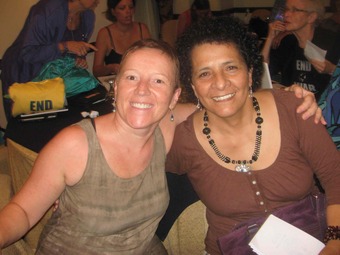
Feminine Interaction
Women adhering to a feminine gender culture often feel more comfortable being intimate with one another.
11.3: Sociological Perspectives on Gender Stratification
11.3.1: The Functionalist Perspective
The functionalist perspective of gender roles suggests that gender roles exist to maximize social efficiency.
Learning Objective
Describe gender inequality from the view of the functionalist perspective
Key Points
- The functionalist perspective sees society as a complex system whose parts work together to promote solidarity and stability. This approach looks at society through a macro-level orientation and broadly focuses on the social structures that shape society as a whole.
- This theory suggests that gender inequalities exist as an efficient way to create a division of labor, or as a social system in which a particular segment of the population is clearly responsible for certain acts of labor and another segment is clearly responsible for other labor acts.
- The feminist movement takes the position that functionalism neglects the suppression of women within the family structure.
Key Terms
- Division of labor
-
A division of labour is the dividing and specializing of cooperative labour into specifically circumscribed tasks and roles.
- The Functionalist Perspective
-
A broad social theory that sees society as a complex system whose parts work together to promote solidarity and stability.
- functionalist perspective of gender inequality
-
A theory that suggests that gender inequalities exist as an efficient way to create a division of labor, or a social system in which a particular segment of the population is clearly responsible for certain acts of labor and another segment is clearly responsible for other labor acts.
The functionalist perspective sees society as a complex system whose parts work together to promote solidarity and stability. This approach looks at society through a macro-level orientation, which is a broad focus on the social structures that shape society as a whole, and looks at both social structure and social functions. Functionalism addresses society as a whole in terms of the function of its constituent elements, namely: norms, customs, traditions, and institutions. A common analogy, popularized by Herbert Spencer, presents these parts of society as “organs” that work toward the proper functioning of the “body” as a whole.
The functionalist perspective of gender inequality was most robustly articulated in the 1940s and 1950s, and largely developed by Talcott Parsons’ model of the nuclear family. This theory suggests that gender inequalities exist as an efficient way to create a division of labor, or as a social system in which particular segments are clearly responsible for certain, respective acts of labor. The division of labor works to maximize resources and efficiency. A structural functionalist view of gender inequality applies the division of labor to view predefined gender roles as complementary: women take care of the home while men provide for the family. Thus gender, like other social institutions, contributes to the stability of society as a whole.
In sociological research, functional prerequisites are the basic needs (food, shelter, clothing, and money) that an individual requires to live above the poverty line. Functional prerequisites may also refer to the factors that allow a society to maintain social order. According to structural functionalists, gender serves to maintain social order by providing and ensuring the stability of such functional prerequisites.
This view has been criticized for reifying, rather than reflecting, gender roles. While gender roles, according to the functionalist perspective, are beneficial in that they contribute to stable social relations, many argue that gender roles are discriminatory and should not be upheld. The feminist movement, which was on the rise at the same time that functionalism began to decline, takes the position that functionalism neglects the suppression of women within the family structure.

A Female Indian Construction
While the structural-functionalist perspective argues that gender inequalities exist as a form of the division of labor, the photograph above clearly illustrates that women need not be restricted to certain activities.
11.3.2: The Conflict Perspective
Conflict theory suggests that men, as the dominant gender, subordinate women in order to maintain power and privilege in society.
Learning Objective
Describe gender from the view of the conflict perpective
Key Points
- Conflict theory asserts that social problems occur when dominant groups mistreat subordinate ones, and thus advocates for a balance of power between genders.
- Frederich Engels compared the family structure to the relationship between the bourgeoisie and the proletariat, suggesting that women had less power than men in the household because they were dependent on them for wages.
- Men, like any other group with a power or wealth advantage in Conflict Theory, fought to maintain their control over resources (in this case, political and economic power). Conflict between the two groups caused things like the Women’s Suffrage Movement and was responsible for social change.
Key Terms
- dominant
-
Ruling; governing; prevailing; controlling.
- subordinate
-
To make subservient.
- proletariat
-
the working class or lower class
- dominant group
-
a sociological category that holds the majority of authority and power over other social groups
According to conflict theory, society is defined by a struggle for dominance among social groups that compete for scarce resources. In the context of gender, conflict theory argues that gender is best understood as men attempting to maintain power and privilege to the detriment of women. Therefore, men can be seen as the dominant group and women as the subordinate group. While certain gender roles may have been appropriate in a hunter-gatherer society, conflict theorists argue that the only reason these roles persist is because the dominant group naturally works to maintain their power and status. According to conflict theory, social problems are created when dominant groups exploit or oppress subordinate groups. Therefore, their approach is normative in that it prescribes changes to the power structure, advocating a balance of power between genders.
In most cultures, men have historically held most of the world’s resources. Until relatively recently, women in Western cultures could not vote or hold property, making them entirely dependent on men. Men, like any other group with a power or wealth advantage, fought to maintain their control over resources (in this case, political and economic power). Conflict between the two groups caused things like the Women’s Suffrage Movement and was responsible for social change.
Friedrich Engels, a German sociologist, studied family structure and gender roles from a Marxist perspective. Engels suggested that the same owner-worker relationship seen in the labor force could also be seen in the household, with women assuming the role of the proletariat. This was due to women’s dependence on men for the attainment of wages. Contemporary conflict theorists suggest that when women become wage earners, they gain power in the family structure and create more democratic arrangements in the home, although they may still carry the majority of the domestic burden.

“And the villain still pursues her! “
A satirical postcard from the Victorian era commenting on a society that is structured so that women are bound by convention to fulfill certain roles and obligations.
11.3.3: The Interactionist Perspective
From a symbolic interactionist perspective, gender is produced and reinforced through daily interactions and the use of symbols.
Learning Objective
Describe gender from the view of the interactionalist perspective
Key Points
- Scholars of interactionism study how individuals act within society and believe that meaning is produced through interactions.
- According to interactionists, gender stratification exists because people act toward each other on the basis of the meanings they have for each other, and that these meanings are derived from social interaction.
- According to Cooley’s concept of the “looking-glass self,” an individual’s understanding of their gender role is based on how society perceives them. Thus, if society views a man as masculine, he will also perceive himself to be masculine.
- “Doing gender” is the notion that masculinity and feminity are performed gender identities. Gender is something we do or perform, not something we are.
Key Terms
- Charles H. Cooley
-
an early twentieth century sociologist who developed the idea of the “looking-glass self”
- masculinity
-
the degree or property of being masculine or manly; manliness
- femininity
-
the sum of all attributes that convey (or are perceived to convey) womanhood
Example
- In 1971, a study conducted by Broverman and Broverman sought to reveal the characteristics that mental health workers attributed to males and females. The traits listed for females include adjectives like gentle, emotional, tactful, unambitious, dependent, passive and neat. On the other hand, the list for the men included adjectives like aggressive, rough, unemotional, blunt, logical, direct, active and sloppy. Notably, when these workers were asked to describe the attributes of a healthy person without a specific gender in mind, the list that was produced was almost identical to the one created for men. This study suggested that there is a tendency to characterize women as being less healthy and less mentally sound than men.
Interactionism
In sociology, interactionism is a theoretical perspective that understands social processes (such as conflict, cooperation, identity formation) as emerging from human interaction. Scholars of this perspective study how individuals act within society, and believe that meaning is produced through the interactions of individuals. According to interactionists, gender stratification exists because people act toward each other on the basis of the meanings they have for one another. Interactionists believe that these meanings are derived through social interaction, and that these meanings are managed and transformed through an interpretive process that people use to make sense of, and handle, the objects that constitute their social worlds.
Goffman and Control
Social interaction is a face-to-face process that consists of actions, reactions, and mutual adaptation between two or more individuals. The goal of social interaction is to communicate with others. Social interaction includes all language, including body language and mannerisms. Erving Goffman, one of the forefathers of this theoretical perspective, emphasized the importance of control in social interactions. According to Goffman, during an interaction, individuals will attempt to control the behavior of the other participants, in order to attain needed information, and in order to control the perception of one’s own image. If the interaction is in danger of ending before an individual wants it to, it can be conserved through several steps. One conversational partner can conform to the expectations of the other, he or she can ignore certain incidents, or he or she can solve apparent problems.
Symbolic Interactionism
Symbolic interactionism aims to understand human behavior by analyzing the critical role of symbols in human interaction. This is certainly relevant to the discussion of masculinity and femininity, because the characteristics and practices of both are socially constructed, reproduced, and reinforced through daily interactions. Imagine, for example, that you walk into a bank, hoping to get a small loan for school, a home, or a small business venture. If you meet with a male loan officer, you might state your case logically, listing all of the hard numbers that make you a qualified applicant for the loan. This type of approach would appeal to the analytical characteristics typically associated with masculinity. If you meet with a female loan officer, on the other hand, you might make an emotional appeal, by stating your positive social intentions. This type of approach would appeal to the sensitive and relational characteristics typically associated with femininity.
Gender as Performance
The meanings attached to symbols are socially created and fluid, instead of natural and static. Because of this, we act and react to symbols based on their current assigned meanings. Both masculinity and feminity are performed gender identities, in the sense that gender is something we do or perform, not something we are . In response to this phenomena, the sociologist Charles H. Cooley’s developed the theory of the “looking-glass self” (1902). In this theory, Cooley argued that an individual’s perception of himself or herself is based primarily how society views him or her. In the context of gender, if society perceives a man as masculine, that man will consider himself as masculine. Thus, when people perform tasks or possess characteristics based on the gender role assigned to them, they are said to be doing gender (rather than “being” gender), a notion first coined by West and Zimmerman (1987). West & Zimmerman emphasized that gender is maintained through accountability. Men and women are expected to perform their gender to the point that it is naturalized, and thus, their status depends on their performance.

Confounding Expectation
The woman in this picture blurs the boundaries between the symbols that are traditionally considered masculine or feminine. While she has long hair and is wearing makeup, typically feminine markers, her clothes are much more masculine in nature.
11.3.4: The Feminist Perspective
Feminist theory analyzes gender stratification through the intersection of gender, race, and class.
Learning Objective
Explain gender stratification from the feminist perspective
Key Points
- Gender stratification occurs when gender differences give men greater privilege and power over women, transgender and gender-non-conforming people.
- Feminist theory uses the conflict approach to examine the reinforcement of gender roles and inequalities, highlighting the role of patriarchy in maintaining the oppression of women.
- Feminism focuses on the theory of patriarchy as a system of power that organizes society into a complex of relationships based on the assertion of male supremacy.
- Intersectionality suggests that various forms of oppression– such as racism, classism, and sexism– are interrelated to form a system of oppression in which various forms of discrimination intersect. The theory was first highlighted by Kimberlé Krenshaw.
- Intersectionality suggests that various biological, social, and cultural categories– including gender, race, class, and ethnicity– interact and contribute towards systematic social inequality. Therefore, various forms of oppression do not act independently but are interrelated.
- Mary Ann Weathers drew attention to the ways in which white women face a different form of discrimination than working class women of color, who additionally must fight racism and class oppression.
Key Terms
- patriarchy
-
The dominance of men in social or cultural systems.
- Intersectionality
-
The idea that various biological, social, and cultural categories– including gender, race, class, and ethnicity– interact and contribute towards systematic social inequality.
- conflict theory
-
A social science perspective that holds that stratification is dysfunctional and harmful in society, with inequality perpetuated because it benefits the rich and powerful at the expense of the poor.
Example
- Mary Ann Weathers demonstrates intersectionality in action in “An Argument for Black Women’s Liberation as a Revolutionary Force.” In this publication, Weathers reveals that in the twentieth century, working-class women of color embodied the notion of intersectionality. The first and second waves of the feminist movement were primarily driven by white women, who did not adequately represent the feminist movement as a whole. It was important to recognize that white women faced a different form of discrimination than working class women of color, who not only had to deal with sexism, but also fight against racism and class oppression.
In sociology, social stratification occurs when differences lead to greater status, power, or privilege for some groups over others. Simply put, it is a system by which society ranks categories of people in a hierarchy. Members of society are socially stratified on many levels, including socio-economic status, race, class, ethnicity, religion, ability status, and gender. Gender stratification occurs when gender differences give men greater privilege and power over women, transgender, and gender-non-conforming people.
Feminist theory is the extension of feminism into theoretical or philosophical discourse. It aims to understand the nature of gender inequality, and examines women’s social roles, experiences, and interests. While generally providing a critique of social relations, much of feminist theory also focuses on analyzing gender inequality and the promotion of women’s interests .
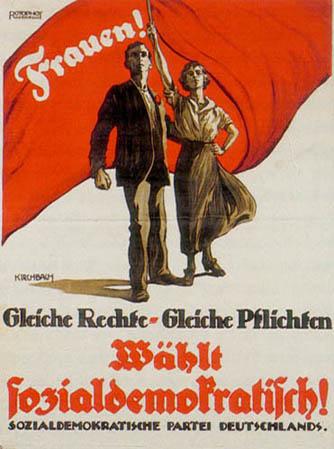
“Women! The same rights, the same duties. “
This 1919 German social democratic election poster advocates for the rights of women. However, did white women face the same challenges that women of other races and ethnic groups did?
Feminist theory uses the conflict approach to examine the reinforcement of gender roles and inequalities. Conflict theory posits that stratification is dysfunctional and harmful in society, with inequality perpetuated because it benefits the rich and powerful at the expense of the poor. Radical feminism, in particular, evaluates the role of the patriarchy in perpetuating male dominance. In patriarchal societies, the male’s perspective and contributions are considered more valuable, resulting in the silencing and marginalization of the woman. Feminism focuses on the theory of patriarchy as a system of power that organizes society into a complex of relationships based on the assertion of male supremacy.
The feminist perspective of gender stratification more recently takes into account intersectionality, a feminist sociological theory first highlighted by feminist-sociologist Kimberlé Crenshaw. Intersectionality suggests that various biological, social and cultural categories, including gender, race, class and ethnicity, interact and contribute towards systematic social inequality. Therefore, various forms of oppression, such as racism or sexism, do not act independently of one another; instead these forms of oppression are interrelated, forming a system of oppression that reflects the “intersection” of multiple forms of discrimination. In light of this theory, the oppression and marginalization of women is thus shaped not only by gender, but by other factors such as race and class.
Mary Ann Weathers demonstrates intersectionality in action in “An Argument for Black Women’s Liberation as a Revolutionary Force.” In this publication, Weathers reveals that in the twentieth century, working-class women of color embodied the notion of intersectionality. The first and second waves of the feminist movement were primarily driven by white women, who did not adequately represent the feminist movement as a whole. It was– and continues to be– important to recognize that white women faced a different form of discrimination than working class women of color, who not only had to deal with sexism, but also fought against racism and class oppression.
11.4: Women as a Minority
11.4.1: Women as a Minority
Women are considered a minority group, because they do not share the same power, privileges, rights, and opportunities as men.
Learning Objective
Criticize the notion that sexism does not exist in the contemporary United States based on the text
Key Points
- Sexism is discrimination or prejudice based on sex. In a patriarchal society, sexism is discrimination against women specifically.
- Women’s rights encompasses the entitlements and freedoms for women and girls of all ages in many societies around the world.
- Although women have made great strides in gaining access to education and employment, to this day they continue to face significant hurdles that men generally do not confront.
Key Terms
- patriarchal
-
relating to a system run by males, rather than females
- women’s rights
-
Entitlements and freedoms claimed by women and girls of all ages in many societies in the pursuit of equality with men.
Women are not a statistical minority, as in most societies — they are roughly equal in number to men — but they do qualify as a minority group because they tend to have less power and fewer privileges than men. Underlying this unequal treatment of women is sexism, which is discrimination based on sex — in the context of a patriarchal society, discrimination against women in particular. Discrimination against women is evident in a number of different spheres of society, whether political, legal, economic, or familial. It must, however, be noted that the issue is rarely as simple as that of men versus women. Societies today are home to a variety of different classes, ethnicities, races, and nationalities, and some groups of women may enjoy a higher status and more power relative to select groups of men, depending on factors, such as what racial and ethnic groups they are associated with.
It should be noted that gender discrimination also ties in with race and class discrimination — a concept known as “intersectionality,” first named by feminist sociologist Kimberlé Crenshaw. For example, the intersectionality of race and gender has been shown to have a visible impact on the labor market. “Sociological research clearly shows that accounting for education, experience, and skill does not fully explain significant differences in labor market outcomes. ” The three main domains on which we see the impact of intersectionality are wages, discrimination, and domestic labor. Most studies have shown that people who fall into the bottom of the social hierarchy in terms of race or gender are more likely to receive lower wages, to be subjected to stereotypes and discriminated against, or be hired for exploitive domestic positions. Through the study of the labor market and intersectionality we gain a better understanding of economic inequalities and the implications of the multidimensional impact of race and gender on social status within society.
Sexism
Sexism can refer to three subtly different beliefs or attitudes:
- The belief that one sex is superior to the other
- The belief that men and women are very different and that this should be strongly reflected in society, language, the right to have sex, and the law
- It can also refer to simple hatred of men (misandry) or women (misogyny)
There a number of examples, both historical and contemporary, of women not being granted the same rights and access as men, both historically and in the present day. For instance, U.S. and English law, until the twentieth century, subscribed to the system of coverture, where “by marriage, the husband and wife are one person in law; that is the very being or legal existence of the woman is suspended during the marriage. ” Not until 1875 were women in the United States legally defined as persons (Minor v Happersett, 88 U.S. 162).
In the United States, women were treated as second-class citizens and not given the right to vote until 1920, when the passage of the Nineteenth Amendment to the U.S. Constitution provided: “The right of citizens of the United States to vote shall not be denied or abridged by the United States or by any State on account of sex. “
Although women have made great strides in gaining access to education and employment, to this day they continue to face significant hurdles that men generally do not confront. In economics, the term “glass ceiling” refers to institutional barriers that prevent minorities and women from advancing beyond a certain point in the corporate world, despite their qualifications and successes. The existence of a glass ceiling indicates that women, even today, do not enjoy the same opportunities as men.
Women’s Rights
Women’s rights are entitlements and freedoms claimed for women and girls of all ages in many societies. In some places, these rights are institutionalized or supported by law, local custom, and behavior, whereas in others, they may be ignored or suppressed. They differ from broader notions of human rights through claims of an inherent historical and traditional bias against the exercise of rights by women and girls in favor of men and boys.
Issues commonly associated with notions of women’s rights include, though are not limited to, the rights to: bodily integrity and autonomy; vote (suffrage); hold public office; work; fair wages or equal pay; own property; be educated; serve in the military or be conscripted; enter into legal contracts; and to have marital, parental, and religious rights.
The Universal Declaration of Human Rights, adopted in 1948, advocates “the equal rights of men and women,” and addresses issues of equality. In 1979, the United Nations General Assembly adopted the Convention on the Elimination of All Forms of Discrimination against Women (CEDAW) for legal implementation of the Declaration on the Elimination of Discrimination against Women. Described as an international bill of rights for women, it went into effect on September 3, 1981. The UN member states that have not ratified the convention are Iran, Nauru, Palau, Somalia, Sudan, Tonga, and the United States. Niue and the Vatican City, which are non-member states, also have not ratified it.
The Convention defines discrimination against women as follows:
Any distinction, exclusion or restriction made on the basis of sex which has the effect or purpose of impairing or nullifying the recognition, enjoyment, or exercise by women, irrespective of their marital status, on a basis of equality of men and women, of human rights and fundamental freedoms in the political, economic, social, cultural, civil, or any other field.
11.4.2: The Origins of Patriarchy
Patriarchy is a social structure in which men are considered to have a monopoly on power and women are expected to submit.
Learning Objective
Argue in favor of either a sociobiological or social constructionist explanation of patriarchy
Key Points
- There are both sociobiological and social constructionist explanations of patriarchy.
- Sociobiological explanations use human biology and genetics to explain male control, while social constructionist explanations say that individuals, male and female, actively construct gender roles.
- According to social constructionist theories, gender roles are created by individuals within a society who choose to imbue a particular structure with meaning.
Key Terms
- gender roles
-
Sets of social and behavioral norms that are generally considered appropriate for either a man or a woman in a social or interpersonal relationship.
- social constructionism
-
The idea that social institutions and knowledge are created by actors within the system, rather than having any inherent truth on their own.
- patriarchy
-
The dominance of men in social or cultural systems.
The origins of patriarchy are closely related to the concept of gender roles, or the set of social and behavioral norms that are considered to be socially appropriate for individuals of a specific sex. Much work has been devoted to understanding why women are typically thought to inhabit a domestic role while men are expected to seek professional satisfaction outside of the home. This division of labor is frequently mapped onto a social hierarchy in which males’ freedom to venture outside of the home and presumed control over women is perceived as superior and dominant. As such, rather than working to destablize the historical notion of patriarchy, much literature assess the origins of patriarchy, or a social system in which the male gender role acts as the primary authority figure central to social organization, and where fathers hold authority over women, children, and property. It implies the institutions of male rule and privilege and entails female subordination.
Though less popular in modern academic circles, there has been a traditional search for biological explanations of gender roles. Before the nineteenth century, this conversation was primarily theological and deemed patriarchy to be the “natural order. ” This took on a biological trope with Charles Darwin’s ideas about evolution in The Origin of Species. In this work, Darwin explained evolution from the biological understanding that is now the accepted scientific theory. Biologists such as Alfred Russel Wallace quickly applied his theory to mankind. To be clear, though, the line of thought called Social Darwinism, or the application of evolutionary principles to the development of human beings and our social practices, was never promoted by Darwin himself. With the popularization of the idea of human evolution, what had previously been explained as a “natural order” for the world morphed into a “biological order. “
The modern term for using biological explanations to explain social phenomena is sociobiology. Sociobiologists use genetics to explain social life, including gender roles. According to the sociobiologists, patriarchy arises more as a result of inherent biology than social conditioning. One such contemporary sociobiologist is Steven Goldberg, who, until retirement, was a sociologist at the City College of New York. In 1973, Goldberg published The Inevitability of Patriarchy, which advanced a biological interpretation of male dominance. Goldberg argued that male dominance is a human universal as a result of our biological makeup. One evolutionary sociobiological theory for the origin of patriarchy begins with the view that females almost always invest more energy into producing offspring than males and, as a result, females are a resource over which males compete. This theory is called Bateman’s principle. One important female preference in selecting a mate is which males control more resources to assist her and her offspring. This, in turn, causes a selection pressure on men to be competitive and succeed in gaining resources in order to compete with other men.
These sociobiological theories of patriarchy are counterbalanced by social constructionist theories that emphasize how certain cultures manufacture and perpetuate gender roles. According to social constructionist theories, gender roles are created by individuals within a society who choose to imbue a particular structure with meaning. Gender roles are constantly toyed with and negotiated by actors subscribing to and questioning them. Since the feminist movement in the 1970s and the flood of women into the workforce, social constructionism has gained even greater traction.
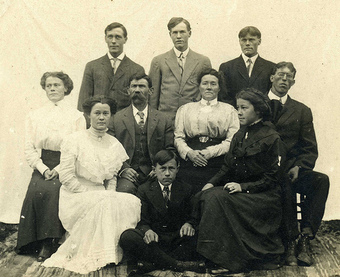
A Family Portrait from the early 1900s
In a patriarchal family, the male acts as the primary authority figure.
11.5: Women in the Workplace
11.5.1: Women in the Workplace
While women are succeeding in a number of professions, they continue to face significant barriers to entry and participation.
Learning Objective
Illustrate two barriers to women’s equal participation in the workforce
Key Points
- A gender role comprises a set of social and behavioral norms that are attritibuted to men and women and that are expected to be adhered to in social settings and interpersonal relationships.
- Historically, the division of labor has been organized according to gender roles and, consequently, certain types of activity are considered more appropriate for men while others are allotted to women.
- Some significant barriers to participation in the workforce women face include network discrimination and access to education, training and capital.
Key Terms
- Gender Role
-
A set of social and behavioral norms that are generally considered appropriate for either a man or a woman in a social or interpersonal relationship.
- Network Discrimination
-
A form of discrimination in which groups hire individuals from their same group, or network, rather than reaching outside to new networks.
Historically, the division of labor has been organized along gender lines. Gender roles – a set of social and behavioral norms about what is considered appropriate for either a man or woman in a social or interpersonal relationship – have affected the specialization of work in both agricultural and industrial societies.
A number of factors over the past few decades have resulted in women entering and flourishing in a variety of different professions. Despite the enormous progress women around the world have made in pursuing careers, there remain significant obstacles women confront in the workplace. The glass ceiling and occupational sexism reflect the restrictions on women as they try to enter and rise in the ranks of the workforce . While occupational sexism and the glass ceiling will be explored in the section ‘Inequalities of work,” what follows is a discussion of barriers to equal participation in the work force, including access to education and training, access to capital, network discrimination and other factors.
Access to Education and Training
A number of occupations became “professionalized” through the 19th and 20th centuries, gaining regulatory bodies and requiring particular higher educational requirements. As women’s access to higher education was often limited, this effectively restricted women’s participation in these professionalizing occupations. For instance, women were completely forbidden access to Cambridge University until 1868, and were encumbered with a variety of restrictions until 1987 when the university adopted an equal opportunity policy. Numerous other institutions in the United States and Western Europe began opening their doors to women over the same period of time, but access to higher education remains a significant barrier to women’s full participation in the workforce. Even where access to higher education is formally available, women’s access to the full range of occupational choices can be limited.
Access to Capital
Women’s access to occupations requiring capital outlays is also hindered by their unequal access (statistically) to capital; this affects individuals who want to pursue careers as entrepreneurs, farm owners and investors. Numerous micro-loan programs attempt to redress this imbalance, targeting women for loans or grants to establish start-up businesses or farms. For example, while research has shown that women cultivate more than half the world’s food, most of the work is family subsistence labor, with family property often legally owned by men in the family.
Network Discrimination
Part of the problem keeping women out of the highest paying, most prestigious positions is that they have historically not held these positions. As a result, recruiters for high-status jobs are predominantly white males, and tend to hire similar people in their networks. Their networks are made up of mostly white males from the same socio-economic status, which helps perpetuate their over-representation in the best jobs.
Other Social and Structural Factors
Through a process known as “employee clustering,” employees tend to be grouped both spatially and socially with those of a similar status job. Women are no exception and tend to be grouped with other women making comparable amounts of money. They compare wages with women around them and believe their salaries are fair because they are average. Some women may be unaware of just how vast the inequality is.
Furthermore, women tend to be less assertive and confrontational than men. Some have suggested that one of the factors contributing to the higher proportion of raises going to men is the simple fact that men tend to ask for raises more often than women, and are more aggressive when doing so. Women and me are socialized at young ages into these roles. School-age boys and girls have been noted as enacting the same aggressive and passive characteristics in educational settings that we see in adults in the workplace.
An additional issue that contributes to income inequality by gender is that women are much more likely than men to take “breaks” in their careers to have children (due to personal choice or as a result of circumstances). When a woman in this scenario re-enters the workforce, she may be offered a smaller salary or a lower position that she might have merited had she remained in the workforce.

Working Women
The Women into Building Housing Showcase is an Australian project designed to promote women in the construction business. The Building Housing Showcase site was constructed by an all-female team.
11.5.2: Inequalities of Work
Women are frequently treated unequally at work, often through sexual harassment and/or wage discrimination.
Learning Objective
Describe two typical manifestations of occupational sexism
Key Points
- Occupational sexism includes any discriminatory practices or statements based on a person’s sex.
- One typical manifestation of occupational sexism is sexual harassment–-the intimidation, bullying, teasing, or coercion of a sexual nature or the unwelcome or inappropriate promise of rewards in exchange for sexual favors.
- Wage discrimination, also known as the gender pay gap, is a phenomenon in which women are consistently paid less for performing the same tasks as men.
- The glass ceiling is an institutional barrier that prevents both women and minorities from advancing beyond a certain point in the workplace.
Key Terms
- pink-collar worker
-
A worker who performs work in the service sector that is considered to be stereotypically female.
- glass ceiling
-
An unwritten, uncodified barrier to further promotion or progression for a member of a specific demographic group.
- gender pay gap
-
The gap in wages between women and men, even when women perform the same tasks as men.
Despite flooding the workplace since the 1970s and 1980s, women still face many institutional challenges to equality in the workplace. The most obvious and publicly condemned example of inequality in the workplace is the prevalence of occupational sexism, or any discriminatory practice, statement, or action based on a person’s sex that occur in a place of employment. One typical manifestation of occupational sexism is sexual harassment–-the intimidation, bullying, teasing, or coercion of a sexual nature, or the unwelcome or inappropriate promise of rewards in exchange for sexual favors. Sexual harassment may be a particular offer extended to an individual (i.e., a promotion in return for sexual rewards) or the general atmosphere created within a workplace. If a workplace engenders an environment that is hostile to women, that workplace is in violation of employment law that bans sexual harassment. However, sexual harassment is not synonymous with workplace inequality. Legally, sexual harassment can be directed by one person of either gender towards another person of either gender. However, inequalities in the workplace typically refer to institutional barriers placed in the way of professional success for women.
Beyond sexual harassment, the most obvious instance of inequality in the workplace is wage discrimination. Frequently referred to as the gender pay gap, this phenomenon observes that women are consistently paid less for performing the same tasks as men. While the exact figure varies in response to a variety of factors, there is little debate that women earn less than men. Women are estimated to earn 76% of what men earn for the same work. In other words, women make 76 cents for every dollar men earn for performing the same task. Part of the pay gap can be attributed to the fact that, more often than men, women tend to engage in part-type work or work in lower-paid industries. This explanation of the pay gap invokes the notion of the pink-collar worker. A “pink-collar worker” is a term for designating the types of jobs in the service industry that are considered to be stereotypically female, such as working as a waitress, nurse, teacher, or secretary. The term attempts to distinguish this type of work from blue-collar and white-collar work. However, not even this acknowledgement explains the entirety of the wage gap, for even women working full time in higher-paid industries earn less than their male colleagues.
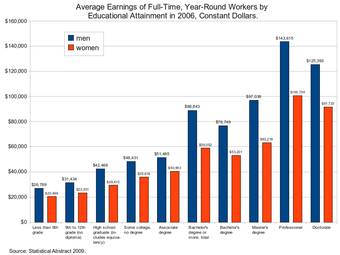
Earning Disparities between Men and Women
The above graph shows the average earnings of workers by education and sex.
The larger schema into which the gender pay gap fits is the notion of a “glass ceiling” for women in the workplace. The term refers to institutional barriers for which there is little hope for legal redress and, thus, appear to be as invisible as glass but that nevertheless limit the rise of women in the workplace. Certainly, the pay gap and other economic issues play into the notion of a glass ceiling, but the term also refers to more general power dynamics. During the 2008 American presidential election, Senator Hillary Clinton’s campaign was considered to contribute to helping shatter the glass ceiling for women in the United States.
11.5.3: Family and Gender Issues
Social expectations that women manage childcare contribute to the gender pay gap and other limitations in professional life for women.
Learning Objective
Recall at least three reasons why there might be a gender pay gap
Key Points
- Because women are expected to handle childcare, they choose jobs with greater flexibility and lower pay.
- The gender pay gap has been attributed to differences in personal and workplace characteristics between women and men (education, hours worked, occupation etc.), as well as direct and indirect discrimination in the labor market (gender stereotypes, customer and employer bias etc.).
- Health care for children and flexible scheduling that can help women with the childcare for which they are still overwhelmingly responsible, may take priority over pay.
Key Term
- gender pay gap
-
The gap in wages between women and men, even when women perform the same tasks as men.
In the United States, there is an observable gender pay gap, such that women are compensated at lower rates for equal work as men. The gender pay gap is measured as the ratio of female to male median yearly earnings among full-time, year-round (FTYR) workers. The female-to-male earnings ratio was 0.77 in 2009, meaning that, in 2009, female FTYR workers earned 77% as much as male FTYR workers. Women’s median yearly earnings relative to men’s rose rapidly from 1980 to 1990 (from 60.2% to 71.6%), and less rapidly from 1990 to 2000 (from 71.6% to 73.7%) and from 2000 to 2009 (from 73.7% to 77.0%).
This discrepancy is frequently attributed to women’s desire to have a family life. Inequalities in professional success are sometimes attributed to women taking maternity leave after having children. Further, women are accused of intentionally seeking out jobs with fewer hours and lower pay in order to be more flexible for their children. Economists who have investigated the gender pay gap have also noted that women are more likely to choose jobs based on factors other than pay. The gender pay gap has also been attributed to differences in personal and workplace characteristics between women and men (education, hours worked, occupation etc.) as well as direct and indirect discrimination in the labor market (gender stereotypes, customer and employer bias etc.).
Health care for children and a flexible schedule that enables women to take care of their children for which they are still overwhelmingly responsible, may take priority over pay. Moreover, many women are disinclined to take jobs that that require travel or are hazardous. On average, women take more time off and work fewer hours, often due to the unequal distribution of childcare and domestic labor. Family obligations tend to pull down on women’s earnings as they proceed through the life course and have more children. The earnings gap tends to widen considerably when men and women are in their early to mid-thirties, or when people start to have children, and reaches its widest point when men and women are in their fifties. The demands of women having to manage work and family lives have become an obsession of American popular culture.

Mother and Ssons from the Akha Hill Tribe
Traditionally, women are expected to stay at home and take care of the children, while men earn wages to financially support their families.
11.5.4: Education and Unequal Treatment in the Classroom
Women have historically been disadvantaged in education, and learning has often been segregated along gender lines.
Learning Objective
Discuss the role of women in the classroom, both in the past and in the present
Key Points
- Disparities in education have shifted in response to various historical factors, and women are now earning more graduate degrees than men.
- Women’s colleges were established in order to educate women, and many of these colleges later merged with male universities.
- Since the early 1990s, more women have been enrolled in college than men.
Key Terms
- coeducational (coed)
-
A college that has both male and female students.
- Seven Sisters colleges
-
A group of the most famous women’s colleges in the United States, including Mount Holyoke, Vassar, Wellesley, Smith, Radcliffe, Bryn Mawr, and Barnard Colleges.
- coordinate colleges
-
Women’s colleges paired with men’s colleges, creating a link between the two schools, but keeping education gender segregated.
Higher education has historically been regarded as a male domain. In early American history, women were sent to tutors and then to female seminaries, though training largely emphasized ladylike accomplishments, such as piano-playing, needlepoint, and literature, over serious academic education. Even as women’s education became more robust, it was considered to be distinct from men’s education. By the mid-1800s, several women’s colleges had been established, and many were coupled with men’s universities as coordinate colleges. In the 1970s and 1980s, some of these coordinate colleges were absorbed into the larger university to create coeducational (coed) universities with both men and women. The most famous women’s colleges in the United States were known as the Seven Sisters colleges and included Mount Holyoke College, Vassar College, Wellesley College, Smith College, Radcliffe College, Bryn Mawr College, and Barnard College. Today, five still operate as women’s-only colleges, Radcliffe no longer accepts students, and Vassar is coeducational.
Despite the integration of men and women in university classrooms, women continue to face gender-based disparities and biases. To this day, math and science are often thought to be , “male” fields, while subjects in the humanities are considered to be the more natural province of women. Of course, particular subjects are not inherently “male” or “female. ” However, gender norms are often informally inculcated at an early age, when elementary school teachers may encourage boys to pursue math and science and not do the same for girls. Further, boys generally receive more positive and negative attention in the classroom than do girls; as a result, the school environment can unintentionally become male-centered.
All of this, however, is changing. As has long been acknowledged, females now earn higher grades than males, and since the early 1990s, more women than men have been enrolled in college. Recently, women have also begun to outnumber men in graduate schools.

Women in Science
A group of girls and boys working on a science project together at Cheltenham Elementary School, Cheltenham, PA, USA
11.5.5: Gender Inequality in Politics
Women have had to fight for equal treatment in politics in the United States by winning the right to vote and a seat at the political table.
Learning Objective
Infer, from the historical struggle for womens’ equal treatment in politics, why gender stereotypes and barriers to equal political participation still exist in the United States
Key Points
- The Nineteenth Amendment to the Constitution gave women the right to vote.
- Gender stereotypes about female politicians and voters still exist.
- Since gaining the right to vote in 1920, women have worked in many levels of government in the United States. In 1981, President Ronald Reagan named Sandra Day O’Connor as the first female Supreme Court justice. Currently, three of the nine sitting justices are women.
- Despite the increasing presence of women in American politics, gender stereotypes still exist. Data from the 2006 American National Election Studies Pilot Study showed that voters of both sexes, regardless of their political persuasions, expected men to perform better as politicians than women.
- Because gender is considered to be a master status, “women” are considered to be a political demographic. In other words, “women” are supposed to have certain political priorities (usually those having to do with children and education) that unite all women as a voting bloc.
Key Terms
- master status
-
A social status that is the primary, socially-identifying characteristic of an individual, such as being the queen.
- women’s suffrage
-
The right of women to vote.
- voting bloc
-
A group of voters that are strongly motivated by a specific common concern or group of concerns to the point that such specific concerns tend to dominate their voting patterns, causing them vote together in elections.
Example
- Examples of powerful female political figures are in evidence throughout the world. Angela Merkel is the first female Chancellor of Germany and Chairwoman of Christian Democratic Union. In South Asia, Benzir Bhutto, a democratic socialist, served as the Prime Minister of Pakistan from 1988-1990 and then again from 1993-1996. Dilma Vana Rousseff is the 36th President of Brazil.
Political Gender Inequality
Even in democratic societies in which gender equality is legally mandated, gender discrimination occurs in politics, both in regards to presumptions about political allegiances that fall along gender lines, and disparate gender representation within representative democracies. Historically, this was even more true when women were neither considered full citizens, nor could not vote.
This section will trace the historical development of women achieving the right to vote and will then consider recent developments as women have achieved political power as representatives, in addition to being members of the voting public. Finally, we will consider assumptions made about women’s political leanings on the basis of gender.
Voting Rights for Women
Before 1920, women did not have a national right to vote in the United States. Women’s suffrage, the movement to achieve the female vote, was won gradually at state and local levels during the end of the nineteenth and early twentieth centuries. In 1920, the Nineteenth Amendment to the United States Constitution was ratified, which provided:
“The right of citizens of the United States to vote shall not be denied or abridged by the United States or by any State on account of sex.”
To appreciate the passing of the Nineteenth Amendment, one must look back to the mid-nineteenth century. The Seneca Falls Convention in 1848 was a single step in a broad and continuous effort by women to gain a greater proportion of social, civil, and moral rights for themselves; but was viewed by many as a revolutionary beginning to the struggle for women’s equality.
Women’s suffrage took a back seat to the Civil War and Reconstruction, but America’s entry into World War I re-initiated a vigorous push. When President Woodrow Wilson announced that America needed to enter the European battlefield in order to protect democracy, women were up in arms. The National Women’s Party became the first cause to picket outside of the White House, with banners comparing President Wilson to his German adversary, Kaiser Wilhelm. The Nineteenth Amendment was passed the year following the Treaty of Paris, which ended World War I.
Women in Recent Politics
Since gaining the fundamental right to vote in 1920, women have worked in many levels of government in the United States. In 1981, President Ronald Reagan named Sandra Day O’Connor as the first female Supreme Court justice. She was later joined by Ruth Bader Ginsburg and has been succeeded by Sonia Sotomayor and Elena Kagan. Currently, three of the nine sitting justices are women. In 1996, President Bill Clinton appointed Madeline Albright to be the first female Secretary of State, a post later given to Condoleezza Rice by President George W. Bush in 2005. Hillary Clinton is the current Secretary of State.
Women in politics took center stage in the 2008 election. In the primary season, New York Senator Hillary Clinton ran against future President Barack Obama for the Democratic nomination. Although Clinton was the twenty-fifth woman to run for U.S. President, she was the first female candidate to have a significant chance of winning the nomination of a major party and the general election.
As such, remarks about her gender and appearance came to the fore. Commentators noted that because she was a woman, Clinton had a sexual power that would make her too intimidating to win the national election. Comments about Clinton’s body, cleavage, choice of pantsuit, and speculation about cosmetic surgery popped up over airwaves. Many wondered if the same fixation on a candidate’s body and style would happen to a male candidate. Commentary about the role of gender in the 2008 presidential election further snowballed when Republican presidential nominee John McCain chose female Alaska Governor Sarah Palin as his vice-presidential running mate.
Gender Stereotyping
Despite the increasing presence of women in American politics, gender stereotypes still exist. Data from the 2006 American National Election Studies Pilot Study confirmed that both male and female voters, regardless of their political persuasions, expected men to perform better as politicians than women. The only deviation in this data had to do with competency in areas such as education that are typically perceived as women’s domains and voters therefore trusted women politicians more.
Because gender is considered to be a master status, or a primary trait around which individuals identify, “women” are considered to be a political demographic. In other words, “women” are supposed to have certain political priorities (usually those having to do with children and education) that unite all women as a voting bloc, or a group of individuals who tend to vote in the same way.
For this reason, political strategists see the “female vote” as one to be won. As such, one will see organizations uniting the female demographic and political priorities, such as “Women for Obama” or “Women for Romney. “
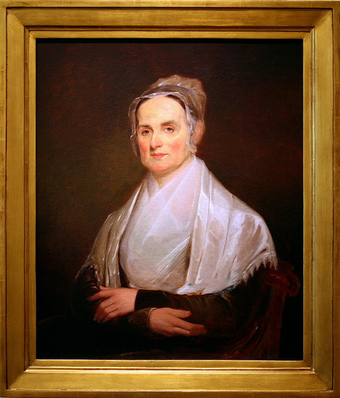
Lucretia Coffin Mott
Mott, along with Elizabeth Cady Stanton, organized the Seneca Falls Convention in 1948, effectively launching the women’s civil rights movement in the United States.
11.5.6: Job Discrimination
Despite legal protections, job discrimination against women still exists in the workplace.
Learning Objective
List the forms of discrimination that women may face on the job
Key Points
- Some women are subjected to sexual harassment and a gender pay gap.
- Stereotypes about the type of work that women can do are commonplace.
- Pink-collar work is a term designating the types of jobs in the service industry that are considered to be stereotypically female, such as working as a waitress, nurse, teacher or secretary.
Key Terms
- sexual harassment
-
intimidation, bullying, teasing, or coercion of a sexual nature, or the unwelcome or inappropriate promise of rewards in exchange for sexual favors.
- pink-collar worker
-
A worker who performs work in the service sector that is considered to be stereotypically female.
- wage discrimination
-
When women earn less than men for performing the same tasks.
Even though there are regulations that are used to promote equality within the workplace, occupational sexism, or any discriminatory practice, statement, or action based on a person’s sex that occurs in a place of employment, is still rampant. The most archetypical manifestation of occupational sexism is sexual harassment, or the intimidation, bullying, teasing, or coercion of a sexual nature, or the unwelcome or inappropriate promise of rewards in exchange for sexual favors. Sexual harassment may be a particular offer extended to an individual (i.e., a promotion in return for sexual rewards) or the generally atmosphere created within a workplace. If a workplace engenders an environment that is hostile to women, that workplace is in violation of the employment law that bans sexual harassment. However, sexual harassment is not synonymous with workplace inequality. Legally, sexual harassment can be directed by one person of either gender towards another person of either gender. Thus, sexual harassment is broader than the simple creation of a professional environment that is not welcoming to women. Women can perpetrate sexual harassment; men can be victims of sexual harassment. However, inequalities in the workplace typically refer to institutional barriers placed in the way of professional success for women.
Beyond sexual harassment, the most obvious instance of inequality in the workplace is wage discrimination. Frequently referred to as the gender pay gap, this phenomenon observes that women are consistently paid less for performing the same tasks as men. Women are estimated to earn 76% of what men earn for the same work. In other words, women make 76 cents for every dollar men earn for performing the same task.
Part of the pay gap can be attributed to the fact that, more often than men, women tend to engage in part-time work or work in lower paid industries. This explanation of the pay gap invokes the notion of the pink-collar worker. A pink-collar worker is a term for designating the types of jobs in the service industry that are considered to be stereotypically female, such as working as a waitress, nurse, teacher or secretary. The term attempts to distinguish this type of work from blue-collar and white-collar work. However, not even this acknowledgement explains the entirety of the wage gap, for even women working full-time in higher paid industries earn less than their male colleagues.

Restoring the Right to Equal Pay between Men and Women
President Obama signs the Lilly Ledbetter Fair Pay Act of 2009 into law.
11.5.7: Gender Inequality in Health Care
Gender discrimination in health care manifests itself primarily as the difference that men and women pay for their insurance premium.
Learning Objective
Identify three ways in which gender inequality in health care manifests itself in the United States
Key Points
- Gender inequality in health care presents itself as women have to pay higher insurance premiums than men.
- Another form of gender inequality in health care is the different rates at which men and women are insured; more women than men are insured in the United States.
- Gender inequalities in health care also revolve around different medicines are covered by insurance companies. For example, the contraceptive mandate demonstrates gender inequities in the different medicine that insurance companies are willing to cover for male and female patients.
- Gender inequality in health care might be reduced under President Obama’s Patient Protection and Affordable Care Act, which outlaws gender discrimination in health care. It would require insurance companies to charge men and women the same rate for health insurance.
Key Terms
- contraceptive mandate
-
A government requirement that health plans—including those offered by religious institutions—offer contraception to policy holders.
- insurance premium
-
The amount charged to a policy holder for a certain amount of insurance coverage.
Assessing gender equity in the health care systems, particularly in the United States, depends heavily upon what factors one considers best to analyze equality.
The Insured
More women than men are insured in the United States. In one study of a population group in a low-income urban community, 86 percent of women reported having access to health insurance through publicly assisted or private options, while only 74 percent of men reported having any health insurance at all. Trends in which women report higher rates of health insurance coverage is not unique to urban, low-income, American populations.
Studies that address percentages of each gender covered by insurance only speak to one measure of inequality in health care.
Insurance Premiums
Gender discrimination in health care manifests primarily as the amount of money one pays for insurance premiums—the amount paid per month in order to be covered by insurance. Women statistically pay far higher premiums than men. This is largely due to regulations of private insurance companies. Fewer than ten state governments prohibit gender discrimination in insurance premiums. For the rest of the union, insurance companies consistently charge their female policy owners more than their male counterparts.
Gender discrimination in health care could be changing in the United States. Under the Patient Protection and Affordable Care Act (informally called “Obamacare”), passed under President Barack Obama in 2010, insurance companies would be prohibited from charging men and women differently. To rationalize gendered rates, insurance companies claim that women use more medical services than men because of pregnancy visits.
Women’s Health
The Obama administration faced another controversy over gender equity in healthcare in 2012 with the administration’s contraceptive mandate. In January of 2012, the Secretary of Health and Human Services, Kathleen Sebelius, announced that all health care plans were required to provide coverage for contraceptives approved by the Food and Drug Administration. The effective meaning of Secretary Sebelius’ announcement was that contraceptives are considered by the Obama administration to be a requisite component of health care.
The premise of the contraceptive mandate demonstrates present inequities in the American health care industry for male and female patients. Whereas services for male reproductive health, such as Viagra, are considered to be a standard part of health care, women’s reproductive health services are called into question. In the context of the 2012 contraceptive mandate debate, health care professionals’ assessments that contraception is an integral component for women’s health care, regardless of sexual activity, went largely unaddressed. Instead, insurance coverage of contraception was framed as a government subsidy for sexual activity.This framing revealed inherent social inequalities for women in the domain of sexual health.

Obama Responds to the Passing of the Health Care Bill
President Barack Obama, along with Vice President Joe Biden and senior staff, respond in the Roosevelt Room of the White House as the House passes the health care reform bill. This bill is seen as a vital step in combating gender inequalities in the health care system.
11.6: Gender-Based Violence
11.6.1: Rape
The definition of rape and its effects on victims have evolved historically alongside ideas about gender and sexuality.
Learning Objective
Describe the influence of the feminist movement on public attitudes toward rape and the notion of consent
Key Points
- Rape has serious psychological and physical consequences for the victim.
- The definitions of rape and consent are culturally and historically contingent upon the particular sexual mores of a time. Recently, the definition or rape has been expanded to include any gender, and now contains stricter definitions of consent.
- Victim blaming and self-blame are rooted in public beliefs that a victim is at least partially responsible for rape. Rape shield laws prohibit legal testimony regarding a victim’s sexual behavior, in order to prevent victims from being placed on trial along with defendants.
- International law defines rape as a crime against humanity and a potentially genocidal act.
- Rape shield laws prohibit legal testimony regarding a victim’s sexual behavior in order to prevent the victim from being placed on trial along with the defendant.
Key Terms
- date rape
-
non-consensual sexual activity between a victim and perpetrator that know one another
- victim blaming
-
when the victim of a crime, an accident, or any type of abusive maltreatment is held entirely or partially responsible for the transgressions committed against him or her (regardless of whether the victim actually had any responsibility for the incident)
- self-blame
-
when one holds oneself responsible for a negative experience
Example
- Definitions of rape and consent have evolved over time. Historically, in Europe, it was commonplace for young girls to be married to older men. Girls as young as six could be married without their consent. Today, statutory rape laws prohibit sexual contact between children and adults. Most states set of the age of consent at 18 and maintain that younger children are incapable of freely giving their consent.
Rape is a type of sexual assault in which one or more individuals forces sexual contact on another individual without consent. Rape can cause devastating physical and psychological trauma. In the aftermath of an attack, many victims develop post-traumatic stress disorder (PTSD), a severe anxiety disorder. Rape victims may also confront a number of emotions related to shame. Often, victims blame themselves for rape. Some victims come to believe they somehow deserved the assault, while others become preoccupied thinking about how the rape could have been avoided.
Although self-blame might seem like an unusual, intensely individual response to rape, it is rooted in social conceptions of rape and victimhood. In the case of rape, victim blaming generally refers to the belief that certain behaviors on the part of the victim, like flirting or wearing provocative clothing, encourage assault. Legal systems may perpetuate victim blaming. For example, in the United States, defendants are guaranteed an opportunity to explain their actions and motivations, which may allow them to instigate conversations about their victims’ sexual past or physical presentation. Lawyers and activists are aware of the negative consequences of this type of conversation in courtrooms, and many have encouraged state legislators to enact rape shield laws, which would prohibit testimony about a victim’s sexual behavior. Nevertheless, victims are often reluctant to report rape because of these social pressures.
Consent
The definition of rape rests on the notion of consent, which has changed over the course of history as sexual mores and understandings of gender have changed. For example, in medieval Europe, a woman could be legally married by her parents to a stranger without her consent and, once married, she could no longer refuse to consent to sex. The medieval concept of rape did not allow for the possibility of being raped by one’s husband. It was only in middle of the 16th century that European courts began to recognize a minimum age of consent, though this figure was typically set around six or seven years. In modern legal understanding, consent may be explicit or implied by context, but the absence of objection never itself constitutes consent, and consent can be withdrawn at any time. Consent cannot be forced and it cannot be given by certain categories of people considered incapable of consent (e.g., minors and the cognitively disabled).
Rape and Gender
Rape is often thought of as a crime committed by a man against a woman, but increasingly, social and legal definitions of rape recognize that this does not have to be the case. In 2012, the Federal Bureau of Investigation updated its definition of rape, which had originally been instituted in 1972, and which previously limited rape to a crime against women. This definition, considered outdated and overly narrow, was replaced by a new definition, which recognizes that rape can be perpetrated by a person of any gender against a victim of any gender. The new definition also broadens the instances in which a victim is unable to give consent. These instances now include temporary or permanent mental or physical incapacity, and incapacity caused by the use of drugs or alcohol.
The FBI’s new definition continues a trend that gained traction with the feminist movement of the 1970s, when rape was publicly characterized as a crime of power and control rather than a sexual act. Leaders of the feminist movement started some of the first rape crisis centers, which not only provided basic services to victims, but also advanced the idea of rape as a criminal act with a victim who was not to be blamed. Feminist leaders also encouraged the codification of marital rape, or forced sexual contact between spouses. Currently, the struggle continues with efforts to bring attention to date rape, which is embedded in the gendered expectation that women engage in sexual activity following a date with a man. Conversations about date rape work to undo this social expectation and to reinforce the idea that consensual sex requires the explicit permission of both partners.
International Law
International law is changing to recognize rape as a weapon of war. The Rome Statute included rape in its definition of a crime against humanity, a definition first put into practice in the mid-1990s by the International Criminal Tribunal for the Former Yugoslavia. This judicial body recognized that Serbian soldiers and policemen had systematically raped Muslim women during the Balkan War. In 1998, the International Criminal Tribunal for Rwanda found that systematic rape was a crime against humanity. It also ruled that rape was an aspect of genocide, because of the use of rape to impregnate women in order to weaken or eliminate a particular gene pool.
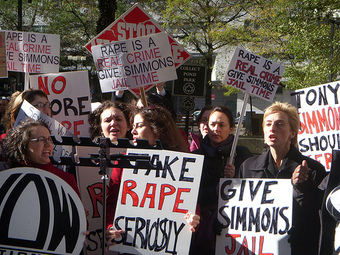
“Rape is a Real Crime, give Simmons Jail Time! “
Women at NOW-NYC’s Take Rape Seriously Rally protest against the inadequate sentence of Tony Simmons, a confessed rapist of three teenage girls.
11.6.2: Sexual Violence
Sexual violence is any sexual act or sexual advance directed at one individual without their consent.
Learning Objective
Explain why sexual violence is difficult to track
Key Points
- An act is deemed sexually violent if the individual to whom the attention is directed does not consent to the sexual activity, if they are members of a class of persons who cannot consent (the severely cognitively impaired, etc.), or if consent is due to coercion or duress.
- Sexual violence has a profound impact on physical and mental health.
- Sexual violence is particularly difficult to track because it is severely under reported.
Key Terms
- sexual assault
-
A physical attack of a sexual nature on another person or a sexual act committed without explicit consent.
- coercion
-
Actual or threatened force for the purpose of compelling action by another person; the act of coercing.
- sexual violence
-
Any sexual act, attempt to obtain a sexual act, unwanted sexual comments or advances, or acts to traffic, or otherwise directed, against a person’s sexuality using coercion, by any person regardless of their relationship to the victim, in any setting, including but not limited to home and work.
Sexual violence is any sexual act or sexual advance directed at one individual without their consent. The most commonly discussed form of sexual violence is rape. Rape is a form of sexual assault involving one or more persons who force sexual penetration with another individual without that individual’s consent. Sexual violence is not limited to rape; it is a broad category that can include everything from verbal harassment to physical assault.
Forms of sexual violence include: rape by strangers, marital rape, date rape, war rape, unwanted sexual harassment, demanding sexual favors, sexual abuse of children, sexual abuse of disabled individuals, forced marriage, child marriage, denial of the right to use contraception, denial of the right to take measures to protect against sexually-transmitted diseases, forced abortion, genital mutilation, forced circumcision, and forced prostitution.
An act is deemed sexually violent if the individual to whom the attention is directed does not consent to the sexual activity, if they are members of a class of persons who cannot consent (the severely cognitively impaired, individuals who are inebriated, minors, etc.), or if consent is due to coercion or duress. Coercion can cover a whole spectrum of degrees of force. Apart from physical force, it may involve psychological intimidation, blackmail, or any other type of threat, like the threat of physical harm or of being dismissed from a job.
Sexual violence has a profound impact on physical and mental health. Sexual violence can cause severe physical injuries, including an increased risk of sexual and reproductive health problems, with both immediate and long-term consequences. Additionally, sexual violence can impact mental health, which can be as serious as its physical impact, and may be even longer lasting.
Acts of Power
Sexually violent acts are acts of power, not of sex. This can be seen most clearly when considering war rape and prison rape. War rape is the type of sexual pillaging that occurs in the aftermath of a war, typically characterized by the male soldiers of the victorious military raping the women of the towns they have just taken over. Prison rape is the type of rape that is common (and seriously under reported) in prisons all over the world, including the United States, in which inmates will force sex upon one another as a demonstration of power.
Tracking Sexual Violence
Sexual violence is particularly difficult to track because it is severely under reported. Records from police and government agencies are often incomplete or limited. Most victims of sexual violence do not report it because they are ashamed, afraid of being blamed, concerned about not being believed, or are simply afraid to relive the event by reporting it. Most countries and many NGOs are undertaking efforts to try to increase the reporting of sexual violence as it so obviously has serious physical and psychological impacts on its victims.
On a global scale, international sexual violence is difficult to track because of extreme variation in sexual mores. A good example of cultural variation with regards to sexual violence is the differing views associated with the practice of female circumcision/female genital mutilation (FGM). Female circumcision and FGM refer to the same practice, but the practice is called “female circumcision” by those who condone its usage. FGM has violent connotations and is used by individuals who conceive of the practice as a violation of human rights.
Female circumcision/FGM is a practice used in many parts of Africa in which parts of the female’s vagina, usually the clitoris, are removed in order to decrease sexual pleasure. The operation is performed most commonly on young females. The practice has been the target of many human rights campaigns as a serious affront to the fundamental human rights of the girls undergoing the operation. However, many individuals in Africa view the practice as an acceptable component of their cultures. Neither vantage point is simple; some women in Africa accept the practice, while others have been vocal in speaking out against the practice. Nevertheless, the case demonstrates that cultural norms associated with sex / sex organs (and therefore sexual violence) can vary widely across cultures.
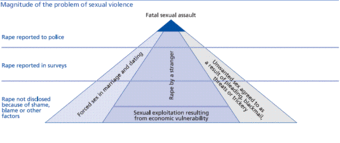
Sexual Violence Reporting
Sexual violence is severly under reported. This graphic illustrates the magnitude of the underreporting of sexual violence
11.6.3: Sexual Harassment
Sexual harassment is intimidation, bullying, teasing, or coercion of a sexual nature.
Learning Objective
Explain when and how sexual harassment is prosecuted in the U.S.
Key Points
- Sexual harassment is common in the workplace.
- Sexual harassment happens any time intimidation, bullying, teasing, or coercion of a sexual nature occurs.
- Sexual harassment is rarely formally charged in a legal context and individuals who do make such charges official are frequently ridiculed.
Key Term
- sexual harassment
-
intimidation, bullying, teasing, or coercion of a sexual nature, or the unwelcome or inappropriate promise of rewards in exchange for sexual favors.
Examples
- The term sexual harassment was actually largely unknown until the early 1990s, when Anita Hill accused Justice Clarence Thomas of sexual harassment during the course of his Senate confirmation hearings for his position on the United States Supreme Court. The Anita Hill case provides an interesting case study of the backlash of accusations of sexual harassment and the strenuous tests that victims’ claims undergo in the public eye.
- In October 1991, Hill said that Thomas had sexually harassed her, as during her two years as Thomas’s assistant, Thomas had asked her out socially several times and, upon her refusal, discussed sexual matters in the workplace.
- Hill faced serious incredulity about her accusations. Four female witnesses were waiting to corroborate Hill’s story, but none were called to testify before the Senate. In light of such opposition, Hill even agreed to take a polygraph to demonstrate her credibility. Though the veracity of such exams is questionable, Hill passed the polygraph. Not surprisingly, Thomas denied Hill’s accusations and was eventually confirmed to the Supreme Court.
- Even after Thomas was confirmed to the Supreme Court, the media continued to question Hill’s accusations and crucify her reputation. The aftermath to Hill’s testimony, from the ad hominem attacks to the professional backlash, reveals an unfortunate reality for many individuals who make public sexual harassment charges.
Sexual harassment is intimidation, bullying, teasing, or coercion of a sexual nature, or the unwelcome or inappropriate promise of rewards in exchange for sexual favors. In most legal contexts this type of behavior is criminalized. The person intimidating a victim about his or her sexuality could be male or female; men and women can both be perpetrators of sexual harassment. Sexual harassment does not have to be only of a sexual nature; indeed, sexual harassment includes unwelcome and offensive comments about a person’s gender. Regardless of whether the content of the sexual harassment is about sex or gender, both victim and harasser can be either male or female and the victim and the harasser can be the same gender.
Though broad, the legal definition of sexual harassment does not include every injurious statement pertaining to sex or gender. The law does not prohibit simple teasing, offhand comments, or isolated incidents that are not very serious. Sexual harassment is illegal when it is so frequent or severe that it creates a hostile or offensive work environment or when it results in adverse employment, such as the victim being fired or demoted. Rather than being a component of criminal law, sexual harassment is typically adjudicated as an issue of employment law. As one might guess, most of these cases turn on whether or not the offensive comment was “serious” or “offhand. ” It is the law’s job to decide if a comment that the victim clearly found serious and offhand is considered so legally.
Even though sexual harassment is less violent than other forms of sexual violence such as rape, victims still suffer serious consequences. Victimhood for individuals subjected to sexual harassment can take a different and equally complicated form as victimhood for individuals who suffer from attacks for physical violence. Sexual violence that is expressed in terms of some sort of physical assault against a victim has become a condemnable act; victims of physical violence are more likely to find others who are sympathetic to their understandable distress. However, sexual harassment is more socially acceptable. Victims will often encounter opposition who claim that the harassment was mere teasing. As such, victimhood in response to sexual harassment has some unique properties. Nevertheless, sexual harassment may lead to temporary or prolonged anxiety, depending on the nature of the harassment and the type of support system in place. Given that harassment is a common problem in the workplace, anxiety on the victim’s part is usually tied into concerns about ramifications for one’s career if one reports the harassment.

Black Noise: Intervention against sexual harassment
Black Noise, an Indian project countering sexual harassment on the streets of India, stages an intervention in a bus.
